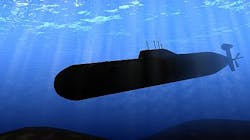SAIC to build prototype ASW deep-sea sonar system that exploits the deep sound channel
SAN DIEGO, 13 Jan. 2012.Undersea warfare experts at Science Applications International Corp. (SAIC) in McLean, Va., are developing deep-sea anti-submarine warfare (ASW) surveillance technology to protect Navy aircraft carriers and their escort ships from quiet enemy attack submarines while the carriers are operating in the open ocean. The new sonar equipment will operate at extreme ocean depths in the so-called "deep sound channel" to detect quiet enemy submarines lurking overhead.
SAIC is doing the work under terms of a 15-month $10.6 million contract modification announced Thursday from The Space and Naval Warfare Systems (SPAWAR) Center Pacific in San Diego. Applied Physical Sciences Corp. in Groton, Conn., also is working on the DSOP program.
This advanced undersea ASW effort is part of the Deep Sea Operations Program, for which SPAWAR awarded the SAIC contract on behalf of the U.S. Defense Advanced Research Projects Agency (DARPA) in Arlington, Va. The contract modification to SAIC brings the cumulative value of this contract to an estimated $12.2 million, Navy officials say.
The DSOP seeks to develop ASW surveillance technology that operates at extreme ocean depths to detect quiet submarines. The program involves sonar and non-acoustic sensors that take advantage of unique signal propagation in the deep ocean.
Navy fixed-site undersea sensor systems today include the Fixed Distributed System (FDS) and the Sound Surveillance System (SOSUS), which are used in ocean choke points in the Caribbean as well as the straits between Greenland, Iceland, Greenland, and the United Kingdom -- commonly referred to as the GIUK Gap.
For the Deep Sea Operations (DSOP) program, Navy and DARPA researchers want to use deep-sea areas called the sound fixing and ranging channel -- also known as the deep sound channel -- that exists at ocean depths below about 3,000 feet where the water is cold, silent, and dense, and where the speed of sound is at its slowest.
Conditions in these areas act as sound waveguides that enable low-frequency sound waves to travel for thousands of miles. DARPA wants to develop sensors that essentially look upward through this acoustically silent environment to detect the low-frequency sounds of enemy submarines against a quiet background at long ranges.
The most recent contract calls for SAIC to build a scalable DSOP sonar system prototype for at-sea testing that can detect and hold track on submarine targets. Later, SAIC engineers will scale the prototype into a potentially deployable system that integrates a broad range of technology for energy use, communications, and planning tools that together demonstrate an advanced deep-sea ASW capability.
While fixed undersea surveillance systems may achieve mobility through rapid deployment, SAIC aims to develop system designs that employ deep ocean platform mobility with advanced power-management subsystems to extend endurance and improve system performance.
Goals of the program include the ability to achieve long-range detection and classification of submarines; the means to communicate underwater over long distances; and the ability to manage electrical energy to operate in hostile deep-ocean conditions for long periods.
Technologies developed under the DSOP must result in sensors that operate near the ocean bottom; take advantage of distributed nodes; can be configured to a range of operations, and environments; and adapt to the mobility of friendly and enemy submarines and surface warships.
In 2010, DARPA began DSOP architecture studies that addressed configurable technology for ASW surveillance over large deep oceans that would operate with distributed and unmanned sensors near the ocean bottom configured to a range of operations, environments, and time scales.
These studies identified key technologies for sensors and processing; communications among DSOP sonar nodes, as well as among nodes and aircraft, surface ships, submarines, and land-based sonar installations; mobility; and energy harvesting, resupply, and storage.
On the current contract, SAIC will do the work in Arlington, Va.; Long Beach, Miss.; San Diego; Austin, Texas; Germantown, Md.; and Melbourne, Fla., and should be finished by April 2013.
For more information contact SAIC online at www.saic.com, SPAWAR at www.spawar.navy.mil, or DARPA at www.darpa.mil.

